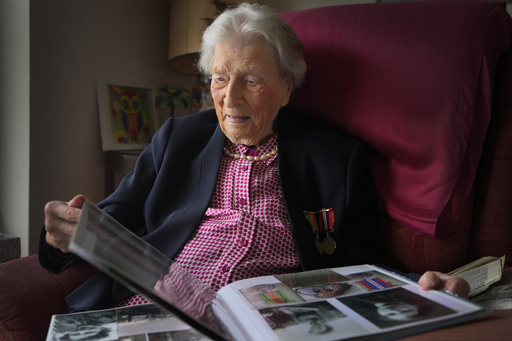LONDON (AP) — Working alone in a tiny office in London, Christian Lamb tried to make sure British troops were in exactly the right place when they scrambled onto Normandy’s beaches under enemy fire during the D-Day landings.
Referring to huge maps of the French coast on the wall in front of her, the young Women’s Royal Naval Service officer painstakingly created detailed maps to guide the crews of landing craft that ferried the men to shore.
The maps “showed railways, roads, churches, castles, every possible feature that could be visible to an incoming invader and from every angle,” Lamb, now 103, told The Associated Press. “It was intense and exciting work, and obviously detail was vital. It was crucial that the maps were 100% accurate.”
Lamb recalls an air of tension as senior military and civilian officials around her prepared for Operation Overlord, the long-discussed Allied invasion of Europe that eventually ended the Nazis’ grip on the continent. Occasionally passing Prime Minister Winston Churchill on the stairs on her way to work, she wondered what kind of pressure Britain’s leader was under.
“He was such an amazing man. I mean, he made these speeches which everybody listened to,” she said. “And I could hear him now saying, ‘We’ll fight on the beaches, fight in the hills. We’ll never surrender.’ We all felt just like that. Absolutely.”
By June 1944, Lamb had been doing her part to defeat the Nazis for almost five years.
In the summer of 1939, she was in France preparing to go to Oxford when her father, a Royal Navy admiral, sent a telegram telling her to come home because war was about to break out. Arriving in Britain on the day war was declared, she immediately joined the Wrens.
A year later, she was in charge of degaussing ships as they entered and exited the Thames estuary. That meant she ensured that ships were demagnetized so they were less susceptible to damage from magnetic mines.
Her next assignment was as a plotting officer at Portsmouth, the home of the Royal Navy. Lamb was part of a team of Wrens who used information from radar stations and coast guards to plot ship movements through the English Channel on a large flat table.
She later took on a similar role in Belfast, plotting the movements of convoys that carried supplies from North America. That included staffing her post as the news came in that a convoy escorted by her future husband’s ship, the destroyer HMS Oribi, had been attacked by a U-boat wolf pack.
Twelve of the convoy’s 43 ships were lost, but HMS Oribi made it safely to Newfoundland. The couple were married six months later in December 1943.
Lamb said she had a special resolve to help drive the Nazis out of France, particularly the centers of art and culture like Caen and Bayeux, where she had studied.
“I really wanted (to do) anything that would help me to get … France back to the French,” she said. “We wanted them to belong to each other again.”



